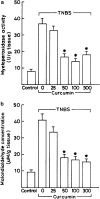Curcumin, the major component of food flavour turmeric, reduces mucosal injury in trinitrobenzene sulphonic acid-induced colitis
- PMID: 12770926
- PMCID: PMC1573841
- DOI: 10.1038/sj.bjp.0705241
Curcumin, the major component of food flavour turmeric, reduces mucosal injury in trinitrobenzene sulphonic acid-induced colitis
Abstract
1 Inflammmatory bowel disease (IBD) is characterized by oxidative and nitrosative stress, leucocyte infiltration and upregulation of proinflammatory cytokines. In this study, we have investigated the protective effects of curcumin, an anti-inflammatory and antioxidant food derivative, on 2,4,6- trinitrobenzene sulphonic acid-induced colitis in mice, a model for IBD. 2 Intestinal lesions (judged by macroscopic and histological score) were associated with neutrophil infiltration (measured as increase in myeloperoxidase activity in the mucosa), increased serine protease activity (may be involved in the degradation of colonic tissue) and high levels of malondialdehyde (an indicator of lipid peroxidation). 3 Dose-response studies revealed that pretreatment of mice with curcumin (50 mg kg(-1) daily i.g. for 10 days) significantly ameliorated the appearance of diarrhoea and the disruption of colonic architecture. Higher doses (100 and 300 mg kg(-1)) had comparable effects. 4 In curcumin-pretreated mice, there was a significant reduction in the degree of both neutrophil infiltration (measured as decrease in myeloperoxidase activity) and lipid peroxidation (measured as decrease in malondialdehyde activity) in the inflamed colon as well as decreased serine protease activity. 5 Curcumin also reduced the levels of nitric oxide (NO) and O(2)(-) associated with the favourable expression of Th1 and Th2 cytokines and inducible NO synthase. Consistent with these observations, nuclear factor-kappaB activation in colonic mucosa was suppressed in the curcumin-treated mice. 6 These findings suggest that curcumin or diferuloylmethane, a major component of the food flavour turmeric, exerts beneficial effects in experimental colitis and may, therefore, be useful in the treatment of IBD.
Figures








References
-
- ALLEN P.C., DANFORTH H.D., AUGUSTINE P.C. Dietary modulation of avian coccidiosis. Int. J. Parasitol. 1998;28:1131–1140. - PubMed
-
- AMMON H.P.T., WAHL M.A. Pharmacology of Curcuma longa. Planta Med. 1991;57:1–6. - PubMed
-
- BROUET I., OHSHIMA H. Curcumin, an anti-tumor promoter and anti-inflammatory agent, inhibits induction of nitric oxide synthase in activated macrophages. Biochem. Biophys. Res. Commun. 1995;206:535–540. - PubMed
-
- CHAN M.M.Y., HUANG H.I., FENTON M.R., FONG D. In vivo inhibition of nitric oxide synthase gene expression by curcumin, a cancer preventive natural product with anti-inflammatory properties. Biochem. Pharmacol. 1998;55:1955–1962. - PubMed
Publication types
MeSH terms
Substances
LinkOut - more resources
Full Text Sources
Other Literature Sources
Medical
Research Materials

